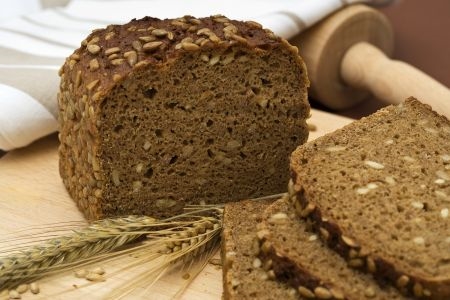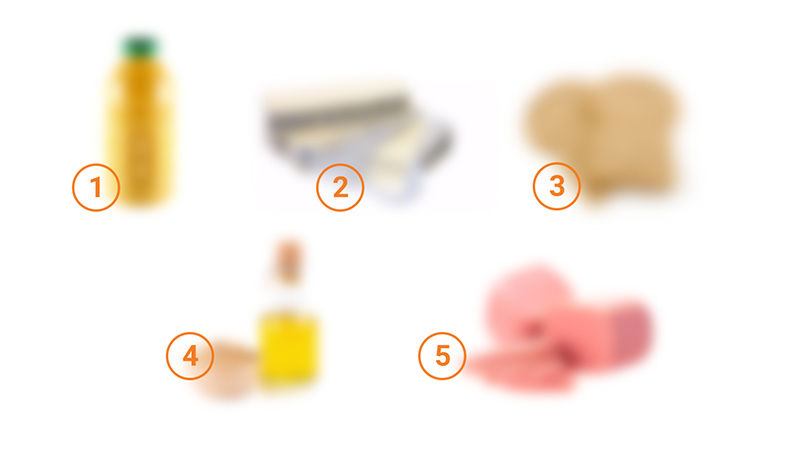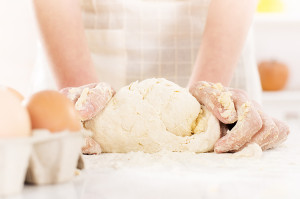You spend extra money on whole wheat bread and you’re positive you’ll enjoy a low glycemic index, nutritional fibers, and generally better health.
Yet you should know that often there’s almost no difference between most whole wheat breads and white bread.
Here’s an explanation why – and what kind of bread you should be looking for.
If you approach the bread shelf at the supermarket, you’ll find a variety of breads, most of them declaring themselves to be made from whole wheat flour.
If you are a diabetic, chances are that people will suggest consuming whole wheat breads. You probably learned that whole wheat bread has a very low glycemic index and therefore lowers your sugar level and your risk of diabetes. But is this really the case?

Nutritional Fibers – All About The Shape
Nutritional fibers are the shells of grains, fruits, and vegetables. We have known for over 50 years that humans cannot digest most parts of fibers, yet they still have a positive effect on our health. “Insoluble” fibers can have a positive effect on the risk of digestive system diseases, including constipation, diverticulosis, and even colon cancer, and “soluble fibers” can lower the risk of myocardial infarction, obesity, and diabetes.
Both types of fibers are important in our diets. The food industry adds these fibers to their already-processed foods and promises great health benefits–but we know that just adding the ground-up fibers isn’t as beneficial.
What is a Glycemic Index?
When we eat carbohydrates, they break down in the digestive system into small particles, which ultimately gets converted into glucose that enters the bloodstream. The rate that glucose enters your blood stream depends partly on the fiber content of the food. This is referred to as the “glycemic index”. Glycemic indices of foods are ranked from 0-100, and categorized according to low, medium, and high.
Theoretically, food that isn’t overly processed will be more complex and will take longer to break down. Therefore, we can assume that the absorption of the glucose into the blood stream would be slower and the glycemic index would be lower. For example, whole corn’s glycemic index is 53 compared to popcorn’s index, which is 72. This means that after the same whole grain altered its structure, it has a completely different effect on the blood sugar’s level.
Whole Wheat Bread vs. White Bread vs. Whole Grain Bread: How They Measure Up
Here’s something that may surprise you. Researchers measured the glycemic index of white bread vs. whole wheat bread, and compared them. It turns out there is no significant difference between the two.
That’s right. Regular whole wheat bread has the same glycemic index as white bread.
This is bad news if you are a diabetic, pre-diabetic, or glucose-intolerant, and thought that “whole wheat bread” was a healthier choice.
However, research that checked the glycemic index of 100% whole grain bread versus white bread, found that the whole grain bread had a significantly lower glycemic index – the lowest in the category, and 30%-40% less than white bread. The more whole grains in the bread, the lower the glycemic index. For example, the glycemic index of whole wheat bread is 92, compared to 69 in bread containing 75% whole wheat grains. Bread consisting of 80% whole barley flour has a glycemic index of 95, compared to a 57 index in bread containing 80% whole barley grains.
According to the United States Food and Drug Administration (FDA), a whole grain is a grain that retains its basic form with key components intact after milling. You can call a grain product “whole grain” if at least 51% of its grains are whole. The grain’s structure and the balance between vitamins, minerals, and “phytochemicals” bring about the beneficial effects, while those same ingredients in their refined and enriched form, separated from the grain, do not have the same benefits.
The label of 100% whole grain assures that a food contains a full serving or more of whole grain in each labeled serving, and that ALL the grain is whole grain. This is what you want to look for when you shop.
Research shows that consuming true whole grains compared to consuming processed grains helps you live longer, makes you feel fuller for longer, and lowers your LDL (bad cholesterol), as well as decreasing the risk of diabetes by 30%.
Which Grain is Best?
Most truly whole grain products are good for you. Research shows that people who ate rye and barley for breakfast instead of white bread had more balanced blood glucose levels not only right after breakfast, but after lunch and dinner as well, demonstrating a sustained effect.
Other research has evaluated whole grains in an even less processed state – sprouted. Sprouting of grains results in grain products with greater nutrient content and digestibility, and less simple starch and antinutrients. A very recent clinical study based in Canada and published in the Journal of Nutrition and Metabolism showed that sprouted grain bread improved the blood sugar level by lowering glucose response (related to glycemic index) and improving activity of a hormone that is also involved in appetite regulation. In overweight and obese men, the glycemic response to sprouted grain bread was lower than with other whole grain test breads, and improved metabolic responses after eating.
So what should you do the next time you’re facing the bread shelf? Don’t let the “wheat” or “whole wheat” label mislead you. Read the list of contents on the label and choose bread that contains 100% whole grain or “sprouted whole grains”.
Just like “whole wheat bread,” you may also be surprised to learn which other “healthy” foods are actually harming your health and preventing you from losing weight.





can i take brown bread in my breakfast and little amount of rice in lunch?
Hi, Jenadivyanshi. Yes, of course. I see that brown bread is already in your breakfast menu, and you can have a little rice (1/2 cup) at lunch instead of another starchy item, such as the potato. We do encourage brown Basmati rice rather than white rice.
just joined, I am totally confused with the bread/ wheat /whole meal information!!! I have looked at your response for this on another members question in 2014. You quote “waitrose LOVE life stoneground wholemeal bread” as one to buy, only when I look at the ingredients in this bread the first item is 100% stoneground wholemeal wheat flour? What is the difference between wholemeal and wholewheat?
thanks
Hi, jothomps37, and welcome. Wholemeal is whole grain, of which wheat is one type. The magic in making a choice is the “100%” number – without it, there is a chance that the bread contains some undesirable refined flours.
I have already queried this, but here it is again. I like Corn Thins which are similar to rice cakes. Will that be okay?
Definitely!
Hi, 9violets. Not so much a recipe, but a set of instructions –
General Instructions
1. Equipment: Quart/liter-sized or larger mason jar and piece of cheesecloth or breathable mesh to fit inside.
2. Preparation:
a. Remove the solid middle insert of the lid, and replace with the prepared cloth.
b. Fill one-third of the jar with whole, unmilled, raw plant food of choice
c. Fill the rest of the jar with warm, filtered water at about a 2:1 ratio
d. Add ½ teaspoon or 2½ grams sea salt, preferably a multimineral type such as Aztec, Himalayan, or Celtic.
e. Screw the lid on with cheesecloth or breathable mesh screen in place.
3. Processing:
a. Soaking: Set aside to soak for 7 hours.
b. Rinsing: Remove the mesh insert of the lid, and replace with metal insert. Pour the soaking water out of the jar, fill with fresh water, replace lid, and rinse well by shaking jar. Replace the metal insert with the mesh lid again, and drain.
c. Draining: Invert the jar and lay at an angle so that air can circulate, and the water can drain off. Allow to sit in+++ the light.
4. Repeat the rinse-drain process every few hours or at least twice daily for 3 days.
In 3 days, the sprouts will be ready, about 3 mm long. Rinse sprouts well, drain, return to jar, place on the solid part of the lid without the mesh, and refrigerate. Use within 2 to 3 days.
is there a recipe for making sprouted whole grain flour?
Hi, Chrisramroop. As long as the grains in that flour are whole, it sounds excellent.
can i use 7 grain flour made from wheat, rye,triticale,barley, corn, millet, brown rice, uckwheat, durum, oats, sunflower seeds, flaxseed to bake bread
Hi, letshaveago, and welcome. Helga’s Wholemeal is considered the gold standard for that type of bread, followed by Burgen’s.
Hi I’m from Australia and only just joined, I’ve just had a look at our multi-grain bread that our family is use to eating and it mentions that it has 12 grains and seeds (a combination of wholegrains and seeds), yet the first ingredient shown is wheat. It doesn’t say 100% wholegrain or sprouted whole grains – are there any that you are aware of in Australia that are 100% wholegrain.
Hi, Richard – that can be fine, but still make sure it is 100% whole grain. Sometimes manufacturers throw in seeds to make up for some refined white flour, and the body doesn’t quite accept that trade-off!
Hi, Jdsimpson. Tesco Wholemeal, Hovis Farmers Wholemeal, Sainsbury’s Medium Wholemeal and Multiseeded Wholemeal SO Organic, Warburton’s Wholemeal, Cranks organic bread wholemeal (BEST of this list), Waitrose LOVE life stoneground wholemeal (2nd BEST of this list), and most wholemeal granary breads – be sure to look at the label and select products that are “wholemeal” and have less than 3 grams of sugars per serving; the best will have some of the flour fermented or sprouted and will not have any E-471 or E-472.
I have just joined the TDC and I am totally confused by the bread thing. I live in England. Can anyone recommend a bread product that is 100% whole grain which can be bought in a regular supermarket?
Thank you
Thankyou
1 more question – We buy multigrain bread is this ok ?
Hi, Richard. Yes, Shredded Wheat is excellent.
Can anyone tell me if Shreaded Wheat is good or bad for your health ?
Hi, rpquirion. Not always – you still need to check for the “100% whole” statement on the label, or check the ingredients list to make sure all the flour ingredients are whole.
Is multigrain considered whole grain?
Hi, Harry. Wholemeal is generally like whole grain, often like 100% whole grain, and so is quite good. Just be sure to read the ingredients list to be sure no refined flours have sneaked in there.
Hi, ayoz. “100%” whole grain or wheat is fine. The challenge is that there are labeling loopholes allowing regular whole wheat and grain products to contain some refined flours – but there are no loopholes for “100%”.
Where does wholemeal bread figure in all of this?
You say above that there is not much difference between white bread and whole wheat bread. Below you tell myronmaxine that whole grain is same as whole wheat, therefore whole wheat should be OK, is this correct?
Hi, Rebobo. That’s great news! We wish you continued success, and are always happy to help.
Thanks so much, big sigh of relief this end. Finding this diet fantastic, a few raised eyebrows with food combos in choose and create section but on the whole, very pleased as so far have lost 5kg in a month. Thanks again for your help.
Hi, Rebobo. Vogels is excellent, and ancient grains are absolutely the way to go – we encourage them wholeheartedly 🙂
Hi, I live in New Zealand, what do you think of the Vogels bread range? So far I think the ancient grains seems to be the best, or am I still off track.
Hi, TablePilot. How a bread is made does indeed have a lot to do with its impact on health. However, if the flour is refined (a.k.a. “white,” not to be confused with “hard white,” which is often whole grain), that is considered to be a major disadvantage.
Hi, Graciewise. Helgas does contain a small amount of trans fats, which we generally recommend to avoid, but the rest of the ingredients are excellent.
I think instead of outlawing white bread you should consider how its made white. wheat is natural brown
Hi, I’m new to trim down club so I thought getting my bread right would be a good start. I’m from Australia and i usually purchase Helgas bread. I usually purchase wholemeal or multigrain. What do you suggest?
Hi, DaisyMaisy1. That particular bread incorporates refined flour in the recipe. Hovis’ wholemeal products are a better bet.
Hi, i’m new to trim down club, please help with the bread choice. I’ve bought Hovis Seed Sensations, is this right or wrong?
Thanks Meg
Hi Sharon
Thank you for your helpful reply. I do my shopping at Tesco, so will get the right one next time!
Hi, DJWaters. What is the name of the bread and company?
Hi, LyndaDyson. That bread is indeed white, so not so recommended. It is not the worst thing in the world, so don’t throw it out, but next time, I suggest to look at the ingredients list on the bread, make sure the “wholemeal flour” ingredient has no number by it (or the number is 100%), there are no hydrogenated fats, and no mystery numbers as additives. The following is an example: http://www.tesco.com/groceries/product/details/?id=285060336.
From UK: Just checked the ingredients for my favourite bread, which is Warburtons Seeded Batch. It describes itself as white bread with five seeds added:- sesame, sunflower, linseed, millet and poppy seeds. The seeds are whole! I am hoping this makes it somewhat better than white bread, but not as good as whole grain bread? Could you enlighten me please? I am only just starting out with this diet and don’t really understand the glycemic index thing.
Hi,
I an getting Chia Bread from our local super market Lovely,
But I can not find out the ingredients can you help? is it good or bad?
Dennis
Very good to know! :@}}}
Hi, myronmaxime. Yes, whole meal is the same as whole grain/wheat – just be sure to check the ingredients list for any refined flours (not noted as “whole”) that may have snuck in.
Hi, Chopin. Thanks for the input. I have forwarded it along to the tech development team.
I was somewhat aware of the health benefits of multi-grain bread but I was mainly attracted to it due to its taste. So it works on a couple of levels.
Question: Why is the text so light here? It looks like a printer running low on ink. I find it difficult to read.
Hi, here in the UK we have also whole meal bread, is that that the same as whole wheat or whole grain bread ?
I know that Ezekiel bread, and the cinnamon raisin bread the company Bread for Life makes, is now found in the freezer section at my local Walmart. Check with your local store, they may be able to get it in your area as well.
Hi, Grandma Mert. See here https://www.trimdownclub.com/recipe/homemade-sprouted-whole-grain-swg-bread/ – you can, of course, just use regular whole grain flour if you wish.
I make bread. Do you have a recipe for whole grained bread? Thanks, Mary
Hi, Trouble2014. Try Whole Foods Market – they have a great selection of the types of foods we recommend. As for specific brands, President’s Choice (http://www.presidentschoice.ca/en_CA/products/productlisting/pc_blue_menu_100_whole_grain_whole_wheat_tortillas17683.html) and Healthy Way (http://www.healthywaybread.com/about/can/whole_wheat_tortilla.html) make wraps (they call them tortillas, and Healthy Way’s are actually made with sprouted grains, which is a bonus). Silver Hills makes sprouted grain/whole grain rolls, and their website has a store locator. (http://www.silverhillsbakery.ca/products/).
I don’t have a problem finding 100% Whole Grain bead in Canada, its made by Dempsters. I have a problem finding whole grain wraps or buns. I can find made with whole grain wheat flour not 100% whole grain. I this okay?
Hi, NanaJC1961. Your bread sounds fine. There are a couple of ways to know if you have a truly whole grain bread.
Some labels actually print “100% Whole Grain”. Another way is to look at the ingredients list, and make sure all the individual flours or seeds indicate “whole”.
the bread I’ve chosen says 12 Whole Grain bread… but the first ingredient on the label says whole wheat flour?? Confusing, so how can you believe that the bread is truly whole grain bread?
I have just been reading your article on bread, recently I have been consuming Treacle bread quite regularly-a cake of bread every 3-4 days. the bread comes from a local bakery, it is quite sweet tasting bread which I slice myself, I now am starting to believe that I should stop eating this treacle bread, as I am now trying to change my eating habits, can you recommend a more healthy alternative to me, as I need to shed some weight, at present 94kgs, target 82kgs or 13 stones, 5ft 7in male.
very useful to read, my mother(home economics teacher) told me all of this but I forgot
thanks for all the great advise. Shopping will be fun again.
Frank from Canada
i live in canada and am able to buy “Dempster’s sprouted grain bread
‘
‘ at the supermarket anytime
Very interesting but where can I buy sprouted whole grains. I would like to start making my own bread again and obviously since it’s more of an effort I would like to use only the most beneficial ingredients. I am 78 years old and want to make the best of my remaining years.
Diana in New Zealand
You can find sprouted grains and higher quality breads at the Whole Foods Market and Fresh Markets or organic markets. I have never found them at the corner grocery store, they are more expensive than your average breads.
this website http://breadlink.co.uk/sproutedflour.html in the UK provides sprouted grain flours – am about to try it. This website cooks with it http://www.virtuousbread.com/bread-and-conversation/baking-with-sprouted-flour/ and as an extra, this website http://nourishedkitchen.com/bone-broth/ gets you back to very nutritious old fashioned bone broths and how to do them amongst other things
Where are the answers , I can’t get hold of 100 Per cent whole grain bread either
It’s very hard 2 get 100% whole mealbread. Tried M/S 2day. Anyone tell me were 2 get it
I eat mostly rye bread. Is all rye bread the same. The Jewish rye looks and tastes different than the rye bread I order at restaurants….the shape and texture resemble white or whole wheat and does not have a good rye flavor. Can you explain the
difference, thanks
I have been looking for sprouted grain flour in UK to make my own bread but not having much luck..iany advice please let me know. Many thanks.
Where in Scotland can I get Sprouted Grain Bread? I have not seen it in any shops.
my husband an I are in the military , the only bread that i can buy that’s wheat is Home Pride is this OK? were living in JAPAN.
is cinnamon ezekial bread swg okay for a slice at breakfast
where can I buy these sprouted whole grains breads in London?
I have researched them but I only found online ordering options
what the best bread to eat ,diabetic b
Very helpful info
So, you use the recipe on the 7 grains hot cereal package? It has a bread recipe on it? We do have one here on the TDC using sprouted grains, if you want to check It out as well. 🙂
I bake my own multi grain bread it is delicious and uses unsalted butter, Bob’s Red Hill Farms 7 grain hot cereal… It’s a hoot, you make the porridge in the mixer bowl! You can add pumpkin seed, if you want or not, I don’t like seeds in my bread. I am thinking to add wheat germ to it. It is 50% whole wheat and 50% unbleached white flour, you get a beautiful sandwich loaf that is not a heavy brick, honey makes it flavourful. Makes beautiful sandwiches, tomato and lettuce .
I eat Ezekiel Sesame bread